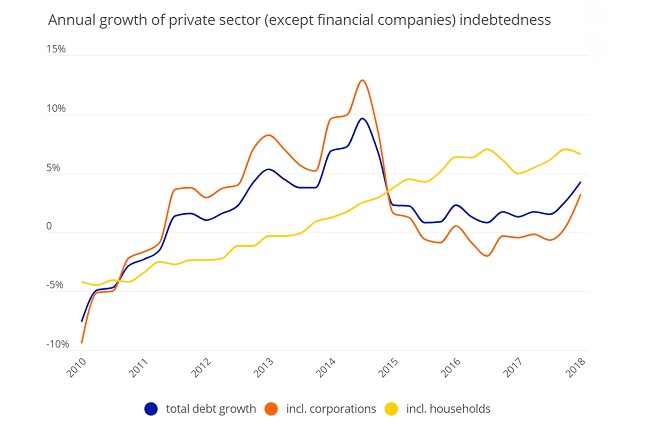Analytics, Banks, Estonia, Financial Services
International Internet Magazine. Baltic States news & analytics
Friday, 26.04.2024, 14:17
The moderate growth of corporate debt reflects the modest level of investment in Estonia
 Print version
Print versionThe growth in the debt of Estonian companies remains moderate. Although the annual growth of total corporate debt accelerated to 3.2% in the first quarter after a three-year standstill, it was still modest considering the favourable economic situation. This is due to the low level of investment that holds back a more prominent increase of long-term debt liabilities first and foremost. At the same time, the decrease in short-term loans taken from foreign associated undertakings has stopped, and if economic activity stays the same, it can be assumed that the growth in total corporate debt may pick up somewhat going forward.
Households are still active borrowers. Demand for loans remained high in the first months of the year, backed by quick income growth, high confidence levels and low interest rates. Households’ debt liabilities increased by about 7% compared to last year, and most of the growth came from housing loans given out by banks, as well as car leases. Loans from other loan providers grew much more slowly than the consumer loans taken out from banks.
The income and savings of households have increased faster than their debt liabilities, which somewhat helps to alleviate the risks associated with fast loan growth. In the first quarter, the outstanding debt liabilities of households were 12% larger than the total volume of their cash and deposits, but the spread has narrowed considerably over the past years. However, the stock of households’ other liquid financial assets (bonds, shares listed on the stock exchange, and investment fund units) remains relatively modest.
The annual growth of the Estonian private sector (companies and households) debt accelerated to 4.3%. Loan growth was therefore smaller than nominal GDP growth. The private sector indebtedness or the debt-to-GDP ratio stood at 118%, the same as the end of last year.









 «The Baltic Course» Is Sold and Stays in Business!
«The Baltic Course» Is Sold and Stays in Business!

